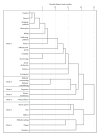Symptoms and Association with Health Outcomes in Relapsing-Remitting Multiple Sclerosis: Results of a US Patient Survey
- PMID: 25328704
- PMCID: PMC4189937
- DOI: 10.1155/2014/203183
Symptoms and Association with Health Outcomes in Relapsing-Remitting Multiple Sclerosis: Results of a US Patient Survey
Abstract
Background. A variety of symptoms have been reported, but the prevalence of specific symptoms in relapsing-remitting multiple sclerosis (RRMS), how they are related to one another, and their impact on patient reported outcomes is not well understood. Objective. To describe how symptoms of RRMS cooccur and their impact on patient-reported outcomes. Methods. Individuals who reported a physician diagnosis of RRMS in a large general health survey in the United States indicated the symptoms they experience because of RRMS and completed validated scales, including the work productivity and activity impairment questionnaire and either the SF-12v2 or SF-36v2. Symptom clusters were identified through hierarchical cluster analysis, and the relationship between clusters and outcomes was assessed through regression. Results. Fatigue, difficulty walking, and numbness were the most commonly reported symptoms. Seven symptom clusters were identified, and several were significantly related to patient reported outcomes. Pain, muscle spasms, and stiffness formed a cluster strongly related to physical quality of life; depression was strongly related to mental quality of life and cognitive difficulty was associated with work impairment. Conclusions. Symptoms in RRMS show a strong relationship with quality of life and should be taken into consideration in treatment decisions and evaluation of treatment success.
Figures


Similar articles
-
Burden of relapsing-remitting multiple sclerosis on workers in the US: a cross-sectional analysis of survey data.BMC Neurol. 2019 Oct 28;19(1):258. doi: 10.1186/s12883-019-1495-z. BMC Neurol. 2019. PMID: 31660897 Free PMC article.
-
A mixed methods approach towards understanding key disease characteristics associated with the progression from RRMS to SPMS: Physicians' and patients' views.Mult Scler Relat Disord. 2020 Feb;38:101861. doi: 10.1016/j.msard.2019.101861. Epub 2019 Nov 18. Mult Scler Relat Disord. 2020. PMID: 31865132
-
Symptom cluster and physical activity in relapsing-remitting multiple sclerosis.Res Nurs Health. 2010 Oct;33(5):398-412. doi: 10.1002/nur.20396. Res Nurs Health. 2010. PMID: 20725947
-
Secondary progressive multiple sclerosis: a systematic review of costs and health state utilities.Curr Med Res Opin. 2021 Jun;37(6):995-1004. doi: 10.1080/03007995.2021.1904860. Epub 2021 Apr 6. Curr Med Res Opin. 2021. PMID: 33733976
-
Glatiramer acetate: a review of its use in relapsing-remitting multiple sclerosis.CNS Drugs. 2002;16(12):825-50. doi: 10.2165/00023210-200216120-00004. CNS Drugs. 2002. PMID: 12421116 Review.
Cited by
-
The effect of fatigue on postural control in individuals with multiple sclerosis: a systematic review.BMC Neurol. 2023 Nov 17;23(1):409. doi: 10.1186/s12883-023-03464-4. BMC Neurol. 2023. PMID: 37978449 Free PMC article.
-
Cost and Quality of Life of Disability Progression in Multiple Sclerosis Beyond EDSS: Impact of Cognition, Fatigue, and Limb Impairment.Pharmacoecon Open. 2024 Sep;8(5):665-678. doi: 10.1007/s41669-024-00501-x. Epub 2024 Jul 1. Pharmacoecon Open. 2024. PMID: 38949748 Free PMC article.
-
Psychosocial and Medical Determinants of Health-related Quality of Life in Patients with Relapsing-Remitting Multiple Sclerosis.Noro Psikiyatr Ars. 2018 Mar 19;55(1):29-35. doi: 10.29399/npa.16983. eCollection 2018 Mar. Noro Psikiyatr Ars. 2018. PMID: 30042638 Free PMC article.
-
Human Umbilical Cord-Derived Mesenchymal Stem Cells in the Treatment of Multiple Sclerosis Patients: Phase I/II Dose-Finding Clinical Study.Cell Transplant. 2024 Jan-Dec;33:9636897241233045. doi: 10.1177/09636897241233045. Cell Transplant. 2024. PMID: 38450623 Free PMC article. Clinical Trial.
-
Sensory Integration Disorders in Patients with Multiple Sclerosis.J Clin Med. 2022 Sep 1;11(17):5183. doi: 10.3390/jcm11175183. J Clin Med. 2022. PMID: 36079113 Free PMC article.
References
-
- Dodd M, Janson S, Facione N, et al. Advancing the science of symptom management. Journal of Advanced Nursing. 2001;33(5):668–676. - PubMed
-
- Wood B, van der Mei IAF, Ponsonby A-L, et al. Prevalence and concurrence of anxiety, depression and fatigue over time in multiple sclerosis. Multiple Sclerosis. 2013;19(2):217–224. - PubMed
-
- Brown RF, Valpiani EM, Tennant CC, et al. Longitudinal assessment of anxiety, depression, and fatigue in people with multiple sclerosis. Psychology and Psychotherapy: Theory, Research and Practice. 2009;82(1):41–56. - PubMed
-
- Motl RW, McAuley E. Symptom cluster as a predictor of physical activity in multiple sclerosis: preliminary evidence. Journal of Pain and Symptom Management. 2009;38(2):270–280. - PubMed
-
- Motl RW, Weikert M, Suh Y, Dlugonski D. Symptom cluster and physical activity in relapsing-remitting multiple sclerosis. Research in Nursing & Health. 2010;33(5):398–412. - PubMed
LinkOut - more resources
Full Text Sources
Other Literature Sources

